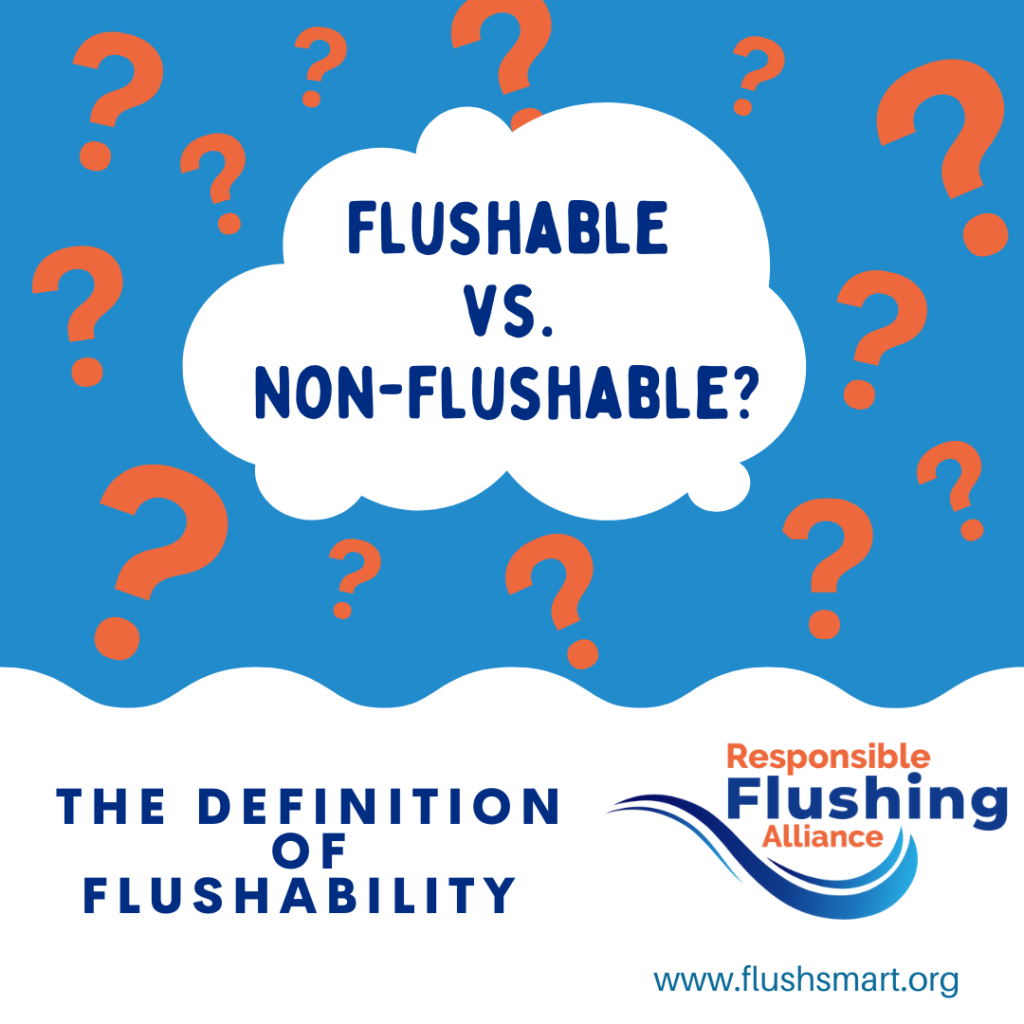Here at the Responsible Flushing Alliance, we always encourage you to practice your best #FlushSmart habits. Sending the wrong products down the drain causes dangerous clogs in municipal sewer systems that could lead to burst pipes, contaminated water, and overflowing sewers. Instead of upgrading infrastructure and wastewater systems or investing precious resources in other community programs, municipalities around the country are unnecessarily spending millions of taxpayer dollars on fixing costly blockages that are completely preventable.
Clogs. Yuck. Well…addressing these gross and dangerous issue boils down to consumer behaviors and really understanding what makes a flushable product flushable. Let’s dig in and discuss the science behind flushable products.
Flushability Standards
Not surprisingly, the science behind flushing stuff is complex and standards range within the industry depending on what product formulation and product use the materials are developed for. Wastewater professionals and product research and development teams acknowledge that there are a variety of ways to decide if a product is flushable or not.
One way is to use a series of tests to see how the product performs under different conditions, such as submerged agitation and dissolvability. These tests can range from making sure a product can get past the toilet to the product’s compatibility with sewage and septic systems and measuring their biodegradability timeframe. There are even tests to see how quickly the product’s material integrity disintegrates in water.
Another way to determine “flushability” is to look at how the product was made. Take a wet wipe for example. Sheets made of short, natural fibers are more likely to be flushable compared to ones made of long, plastic fibers. Short fibers pull apart easier, allowing the product to disintegrate once flushed. Meanwhile, long fibers are designed to bend and stretch for those times you need a durable wet wipe.
When flushed, these long-fiber wipes, such as baby or cleaning wipes, don’t break down in water and can adhere to fats, oils and grease in sewers to form cement-like fatbergs. And if they make it to the wastewater treatment facility, they can wrap around pumps, causing extensive damage and costly repairs.
While both wet wipes serve their own purpose to keep our homes safe and healthy, they need to be disposed of in very different ways! You can check out our flyer for a quick breakdown on what makes a flushable vs non-flushable wipe!
The Gold Standard
There is one final way to know for sure if a product is flushable, and that comes down to the “Do Not Flush” symbol! This symbol can be found on all your favorite wipes products that do not belong down the drain. If you’re ever unsure of the best way to dispose of a product, just check the packaging. You can also check out the list below for a cheat-sheet on what cannot be flushed.
What Not to Flush:
- Baby Wipes or Household Cleaning Wipes
• Paper Towels, Facial Tissue, Makeup Wipes
• Fats, Oils, and Grease
• Food, Trash, Plastic Bags
• Rags, Cloth, Disposable Gloves
• Cotton Balls, Cotton Swabs, Dental Floss
• Feminine Products
• Hair/Hair Weaves
• Medications/Syringes
The Responsible Flushing Alliance is leading the way with its #FlushSmart consumer education campaign. RFA is dedicated to keeping homes and communities healthy through proper flushing practices. This includes supporting clear and prominent labeling of all items that should not be flushed, including promotion of the “Do Not Flush” symbol on non-flushable wipes.
For more information, go to http://www.flushsmart.org or @flushsmart on Twitter or Facebook.
About Responsible Flushing Alliance
The Responsible Flushing Alliance (RFA) is a 501(c)(6) non-profit organization dedicated to consumer education focused on what not to flush. RFA’s goal is to change consumer behavior to help reduce damage to our nation’s sewage systems caused by objects and materials not designed to be flushed.
Responsible Flushing Alliance Supporting Members
Albaad Inc., ANDRITZ Group – Nonwoven Division, DUDE Products, Dukal, LLC., Essity, First Quality, Glafelter, Johnson & Johnson, Kelheim Fibres, Kimberly-Clark Corporation, Nehemiah Manufacturing, Nice-Pak and PDI, Papel Aralar S.A., Procter & Gamble, Rockline Industries, Sellars Nonwovens, and Suominen Corp., Spartan Chemicals., Reckitt.
Responsible Flushing Alliance Advisory Members
California Association of Sanitation Agencies (CASA), National Association of Clean Water Agencies (NACWA), National Stewardship Action Council (NSAC), H20 Global News, Toilet Board Coalition, Baby and Adult Hygiene Products (BAHP).
